The Trinidad and Tobago Field Naturalist Club is a group dedicate to preserving and enjoying the natural environment of the country. The clubs mission is “to foster education and knowledge on natural history and to encourage and promote activities that would lead to the appreciation, preservation and conservation of our natural heritage.” I’m now a member and I’m anticipating Rich will be too when he actually gets here permanently. The club has monthly evening business meetings in Port of Spain with a featured speaker on issues relevant to the club. I’ve been to two business meetings now. At the first one, the featured speaker is running an organic agriculture and resource restoration project in one of the valleys (Caura) in the northern range. This month the speaker was a UWI researcher doing a coral reef restoration project.
The club also has special interest groups on birds, insects, botany, and environmental issues and sponsors regular field outings. Saturday (March 15) was the botany group outing to Monos Island. If you look at a map, you will see that there is a string of three islands coming off the tip of Trinidad’s north west peninsula extending over toward Venezuela, these are known as the Bocos islands. The one closest to Trinidad is Monos Island. Its name stems from the monkeys that once lived there but there are no monkey’s on the island now. Just to the south of Bocos Island is a forth island, Gaspar Grande. Most of the rain in Trinidad comes from the north east off the Atlantic which puts the Bocos islands in something of a rain shadow. The vegetation there is adapted to a much drier climate than what is found in the northern range. There are many cactus and deciduous trees that loose their leaves during the dry season. By southwestern US standards, its very didn’t seem very dry and the vegetation was nearly as dense as the rain forests, just dominated by different species.
We had to get up shortly after 5 am in order to meet the club in POS by 6:30 am. Then we drove out to Williams Bay on the north west peninsula where all 24 of us packed onto an open boat, put on life vests and headed up the coast and across the Boca to Monos Island. The red X on the map of Monos Island below shows the approximate location where the boat dropped us off. From there we hiked along the shore to the base of the little bay and then a ways up the valley (yellow line).

The whole Island is less than two miles across so it wasn’t a very long hike but then we weren’t there to hike and weren’t moving very fast either. We were there to survey the vegetation growing on the Island. We had a couple of guides with expertise in the local vegetation including the expert from the UWI Herbarium as well as several very experienced club members. When we got off the boat we had a not so brief overview of our objectives for the day including a long list of plants that had been documented previously on the island and some particular plants we were looking to find.
Rich and I weren’t of much use identifying plants since this is a totally new ecosystem for us. We did however learn a lot. Some of things I think of as solely domesticated house plants like philodendrons, croton, sansevieria and many orchids grow all over hear in the wild. Along the shoreline there were all these holes that looked for all the world like gopher holes. It turns out they are dug by crabs. There are these little tiny geckoes that like to live between the trunks and leaves of young palms. We were shown two species of orchids that grow on the Island although neither of them was currently in bloom. The seeds of them is transported to Trinidad from Africa with Saharan dust storms and Rich is anxious to see if we can use it to track areas that are impacted by the dust.
I even remember the names of some of the plants we learned. Here are a few of them. Below is picture of a silk cotton tree (Ceiba petandra) also known as Kapok. The trunk of this tree is covered with huge thorns, enough to scare off all but the most intrepid tree hugger. It is reputed to have large read flowers, but it wasn’t blooming this time of year so I can’t confirm. The fruits of the tree produce a cotton like fiber (Kapok) which is used as a batting and stuffing in some parts of the world. Rich remembers cheap sleeping bags made with Kapok from his childhood. The tree has never been grown commercially in the carribean but seems to grow all over Trinidad. There are lots of superstitions associated with the silk cotton tree. At one time people believed these trees could move around and gather together (like Ents!).
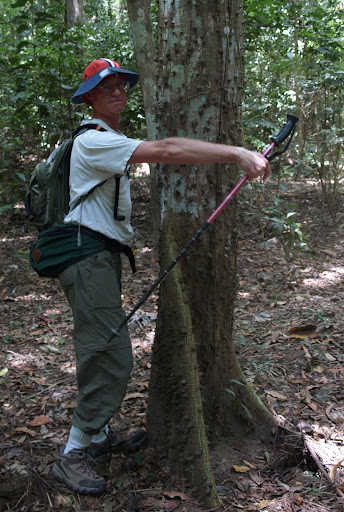

The tree pictured below is “Theobroma cacao”. That’s right, it’s a Cocoa tree. The yellow fruits growing from the trunk contain cocoa beans. The second picture is of one of the pods broken open so you can see the cocoa beans. We sucked and chewed a bit the fresh cocoa beans. The white stuff on the outside of the beans is sweet and quite tasty but doesn’t taste anything like processed cocoa. The beans have to be fermented and roasted before they take on the characteristic chocolate flavor.
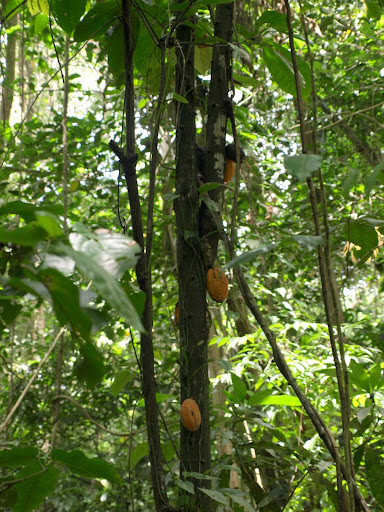

The next picture is of the tropical almond. The nuts from this tree were scattered all over the ground near where we ate lunch. The shells don’t look quite like domestic almonds but one of our guides was able to break a few open and the nuts themselves look and taste just about like domestic almonds. We’ll have to bring along tools to crack them open on future costal hikes. The nuts from the tree float well so the tree is found throughout the tropics. As a side note, I remember seeing this tree and the nuts in Hawaii but everyone I asked about them told me they weren’t nuts and weren’t edible. Just goes to show you shouldn’t believe everything you hear.
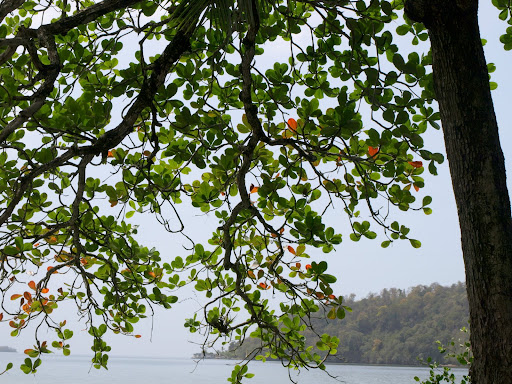
The two pictures below are of a tree called “The Naked Indian” (Bursera simaruba) and its berries. There are two species of this tree that grow in this area and one of our goals was to find if both of the species were present on Monos Island. Only one had been confirmed in the past but they are easy to confuse. Both species have the same peeling bark, which earns the tree its name. There are distinguishing features in the leaves and the fruits. Unfortunately, most of the trees had lost their leaves this time of year which made the job of distinguishing the two trees more difficult. Some of the trees had berries on them. Dan, one of the experience TTFNC members, is incredibly good at throwing rocks and stick accurately enough to knock samples of things like berries off really high branches. The berries of the naked Indian are used in incense and have a pleasant juniper like smell. Toward the end of our expedition, we did find one Naked Indian with leaves down low and our expert was able to identify it definitively as the second species that hadn’t previously been confirmed on the Island which made everyone happy.
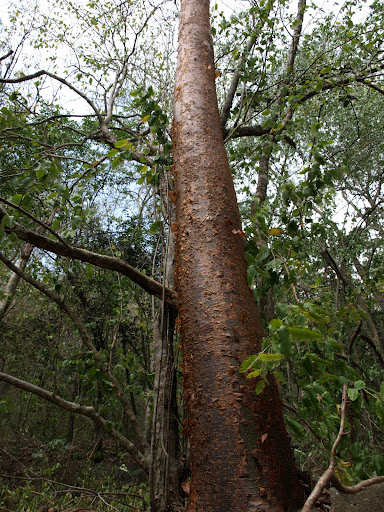
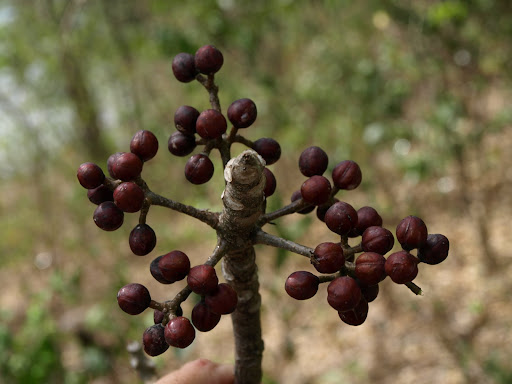
One of the more interesting things we came across was a rubber tree. This isn’t the most common commercial rubber tree but it does produce usable rubber. In the first picture below you can see Dan pulling on some old oxidized rubber stuck to the trunk of the tree and cutting a small gash in the tree with his machete. In the second picture you can see the free rubber latex running down from the spot where Dan cut the tree. Evidently the latex will keep running like this for about a day after the tree is cut.
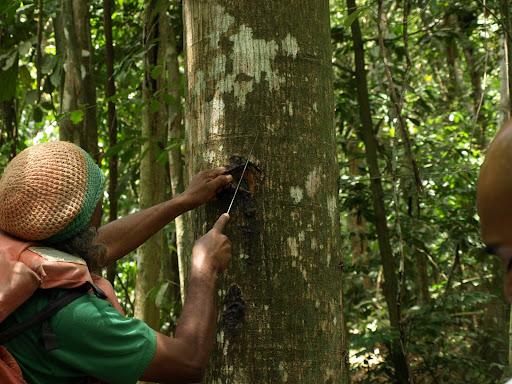
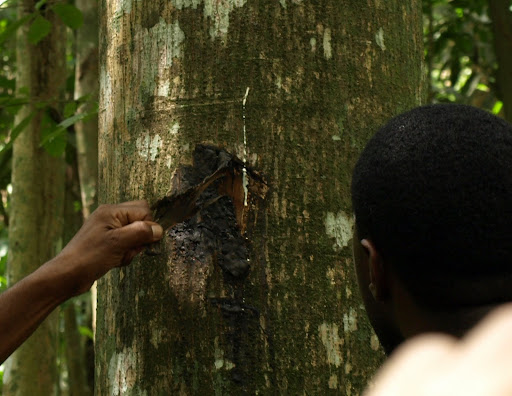
When it hit noon, we quit working and limed (Trini for hanging out) a bit on beach at the bottom of the bay. We ate lunch, visited and swam in the bay, then headed back to our drop off point to meet the boat at 3 pm. It was a successful trip for TTFNC. We identified several plants that haven’t been recorded on Monos Island previously, found a number of things even our experts couldn’t identify off hand and collected pictures and samples to take back to the herbarium for identification. Rich and I learned a lot of stuff about our new environment and started some friendships with a bunch of people that have common interests. All in all a wonderful day!




No comments:
Post a Comment